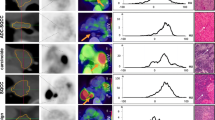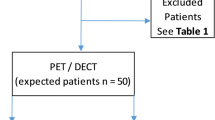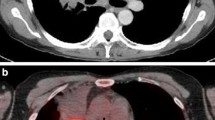Abstract
Purpose
The demand to optimize multidisciplinary treatment strategies in patients with benign and malignant diseases of the lung and other organs has led to the increased need of mechanistic proof-of-concept studies in preclinical small animal models using new non-invasive imaging methods. Therefore, we evaluated the role of microPET and microCT for mediastinal lymph node staging in an orthotopic lung cancer model in rats.
Procedures
Human lung cancer cells (NCI-H460) were injected transthoracically in nude rats (NIH-RNU). After 2 weeks of tumour growth, animals underwent multiphase contrast-enhanced microCT using ExiTron nano 12000 as a contrast agent and dynamic microPET using the tracer 2-deoxy-2-[18F]fluoro-d-glucose ([18F]FDG). Thereafter, animals were sacrificed for histological analysis.
Results
Late phase micro X-ray computed tomography (microCT) revealed the best delineation of lymph node metastases, as compared to earlier scans. In terms of an increased [18F]FDG uptake over time, dynamic micro positron emission tomography (microPET) delineated lymph node metastases and enabled metabolic examinations of the induced lung cancer metastases.
Conclusion
The combination of contrast-enhanced microCT and dynamic microPET is feasible in rats for the visualization of mediastinal lymph node metastases.



Similar content being viewed by others
References
Rivera MP (2013) Lung cancer in women: differences in epidemiology, biology, histology, and treatment outcomes. Crit Care Med 34:792–801
Abramyuk A, Appold S, Zophel K et al (2012) Quantitative modifications of TNM staging, clinical staging and therapeutic intent by FDG-PET/CT in patients with non small cell lung cancer scheduled for radiotherapy-a retrospective study. Lung Canc 78:148–152
Kratochwil C, Haberkorn U, Giesel FL (2010) PET/CT for diagnostics and therapy stratification of lung cancer. Radiologe 50:684–691
Rami-Porta R, Call S (2012) Invasive staging of mediastinal lymph nodes: mediastinoscopy and remediastinoscopy. Thorac Surg Clin 22:177–189
Saha D, Watkins L, Yin Y et al (2010) An orthotopic lung tumor model for image-guided microirradiation in rats. Radiat Res 174:62–71
Liu J, Blackhall F, Seiden-Long I et al (2004) Modeling of lung cancer by an orthotopically growing H460SM variant cell line reveals novel candidate genes for systemic metastasis. Oncogene 23:6316–6324
Boll H, Figueiredo G, Fiebig T et al (2013) Comparison of Fenestra LC, ExiTron nano 6000, and ExiTron nano 12000 for micro-CT imaging of liver and spleen in mice. Acad Radiol 20:1137–1143
Boll H, Bag S, Schambach SJ et al (2010) High-speed single-breath-hold micro-computed tomography of thoracic and abdominal structures in mice using a simplified method for intubation. J Comput Assist Tomogr 34:783–790
Haberkorn U, Hoffend J, Schmidt K et al (2007) Changes in glucose metabolism and gene expression after transfer of anti-angiogenic genes in rat hepatoma. Eur J Nucl Med Mol Imaging 34:2011–2023
Cheng C, Alt V, Pan L et al (2014) Application of F-18-sodium fluoride (NaF) dynamic PET-CT (dPET-CT) for defect healing: a comparison of biomaterials in an experimental osteoporotic rat model. Sci Monit 20:1942–1949
Dimitrakopoulou-Strauss A, Strauss LG, Rudi J (2003) PET-FDG as predictor of therapy response in patients with colorectal carcinoma. Q J Nucl Med 47:8–13
Dimitrakopoulou-Strauss A, Hoffmann M, Bergner R et al (2007) Prediction of short-term survival in patients with advanced nonsmall cell lung cancer following chemotherapy based on 2-deoxy-2-[F-18]fluoro-D-glucose-positron emission tomography: a feasibility study. Mol Imaging Biol 9:308–317
Haberkorn U, Strauss LG, Dimitrakopoulou A et al (1993) Fluorodeoxyglucose imaging of advanced head and neck cancer after chemotherapy. J Nucl Med 34:12–17
Reischauer C, Froehlich JM, Pless M et al (2014) Early treatment response in non-small cell lung cancer patients using diffusion-weighted imaging and functional diffusion maps—a feasibility study. PLoS One 9:e108052
Hicks RJ (2009) Role of 18F-FDG PET in assessment of response in non-small cell lung cancer. J Nucl Med 50(Suppl 1):31S–42S
Takenaka D, Ohno Y, Koyama H et al (2010) Integrated FDG-PET/CT vs. standard radiological examinations: comparison of capability for assessment of postoperative recurrence in non-small cell lung cancer patients. Eur J Radiol 74:458–464
Gorenberg M, Bar-Shalom R, Israel O (2008) Patterns of FDG uptake in post-thoracotomy surgical scars in patients with lung cancer. Br J Radiol 81:821–825
Weber WA, Petersen V, Schmidt B et al (2003) Positron emission tomography in non-small-cell lung cancer: prediction of response to chemotherapy by quantitative assessment of glucose use. J Clin Oncol 21:2651–2657
Erasmus JJ, Patz EF Jr, McAdams HP et al (1997) Evaluation of adrenal masses in patients with bronchogenic carcinoma using 18F-fluorodeoxyglucose positron emission tomography. AJR Am J Roentgenol 168:1357–1360
Yamamoto Y, Kameyama R, Murota M et al (2009) Early assessment of therapeutic response using FDG PET in small cell lung cancer. Mol Imaging Biol 11:467–472
Lee DH, Kim SK, Lee HY et al (2009) Early prediction of response to first-line therapy using integrated 18F-FDG PET/CT for patients with advanced/metastatic non-small cell lung cancer. J Thorac Oncol 4:816–821
Nahmias C, Hanna WT, Wahl LM et al (2007) Time course of early response to chemotherapy in non-small cell lung cancer patients with 18F-FDG PET/CT. J Nucl Med 48:744–751
Acknowledgments
This work was supported by grants from the Bundesministerium für Bildung und Forschung (82DZL00401; 82DZL00402). We thank Dr. Andreas Briel for supporting the analysis of the contrast-enhanced microCT data and Alexandra Tietz and Karin Leotta for technical assistance with the establishing of the tumour model and the small-animal imaging procedures.
Conflict of Interest
There is no potential conflict of interest relevant to this article.
Author information
Authors and Affiliations
Corresponding author
Rights and permissions
About this article
Cite this article
Flechsig, P., Kratochwil, C., Warth, A. et al. A Comparison of microCT and microPET for Evaluating Lymph Node Metastasis in a Rat Model. Mol Imaging Biol 18, 243–248 (2016). https://doi.org/10.1007/s11307-015-0890-0
Published:
Issue Date:
DOI: https://doi.org/10.1007/s11307-015-0890-0




